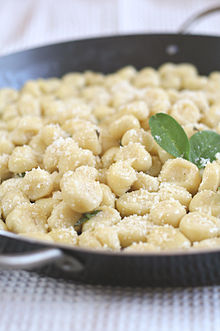Gnocchi: Difference between revisions
copyedit + sections |
No edit summary |
||
| Line 34: | Line 34: | ||
{{commonscat-inline|Gnocchi}} |
{{commonscat-inline|Gnocchi}} |
||
* [http://www.foodnetwork.com/food/recipes/recipe/0,,FOOD_9936_5283,00.html Gnocchi Recipe] |
* [http://www.foodnetwork.com/food/recipes/recipe/0,,FOOD_9936_5283,00.html Gnocchi Recipe] |
||
* [http://www.potatoricer.org.uk Gnocchi Recipes] |
|||
[[Category:Staple foods]] |
[[Category:Staple foods]] |
||
Revision as of 08:34, 29 December 2009




- For the Italian Baroque composer, please see Pietro Gnocchi.
Gnocchi (/ˈnɒki/; Italian: [ˈɲɔkːi]; singular gnocco) is the Italian name for a variety of thick, soft noodles or dumplings. They may be made from semolina, ordinary wheat flour, potato, bread crumbs, or similar ingredients. The smaller forms are called gnocchetti.
Gnocchi are eaten in Italy as entrées (primi piatti), alternatives to soups (minestre), or pasta. They are widely available dried, frozen, or fresh in vacuum sealed packages in supermarkets and Italian specialty stores. Classic accompaniments of gnocchi include tomato sauces, pesto, and melted butter (sometimes fried butter) with cheese.
Origin
The word gnocchi means "lumps", and may derive from nocchio, a knot in the wood,[1] or from nocca (knuckle).[2] It has been a traditional Italian pasta type of probably Middle Eastern origin since Roman times.[3] It was introduced by the Roman Legions during the enormous expansion of the empire into the countries of the European continent. In the past 2000 years each country developed its own specific type of small dumplings, with the ancient gnocchi as their common ancestor. In Roman times, gnocchi were made from a semolina porridge-like dough mixed with eggs, and are still found in similar forms today, particularly Sardinia's malloreddus (although they do not contain eggs).
The use of potato is a relatively recent innovation, occurring after the introduction of the potato to Europe in the 16th century.[4]
Regional varieties
One variety, gnocchi di pane (literally "bread noodles"), is made from bread crumbs and is popular in Friuli and Trentino-Alto Adige/Südtirol. Another variety from the latter region is spinach gnocchi, called strangolapreti. This translates to "choke the priest".
In France
The name is also used in France in the dish known as "gnocchis à la parisienne", a hot dish comprising gnocchi formed of choux pastry, and served with Béchamel sauce.
See also
References
- ^ Oxford English Dictionary, 2nd edition, 1989
- ^ Lo Zingarelli, 2008.
- ^ Serventi, Silvano (2002). Pasta: The Story of a Universal Food. Trans. Antony Shugaar. New York: Columbia University Press. p. 17. ISBN 0231124422.
{{cite book}}: Unknown parameter|coauthors=ignored (|author=suggested) (help) - ^ Theisen, K. "World Potato Atlas: China - History and Overview". International Potato Center.
- Notes
- Davidson, Alan. The Oxford Companion to Food, s.v. gnocchi.
- Jenkins, Nancy Harmon. Flavors of Tuscany. 1998.
External links
![]() Media related to Gnocchi at Wikimedia Commons
Media related to Gnocchi at Wikimedia Commons
